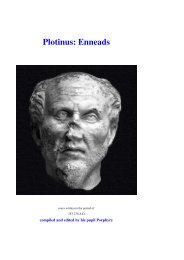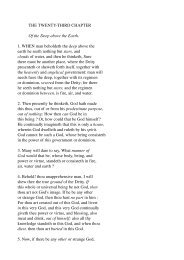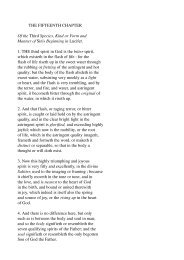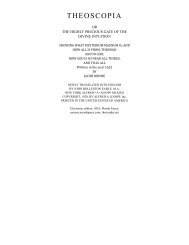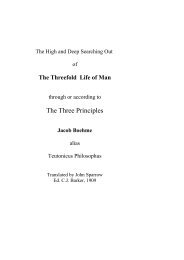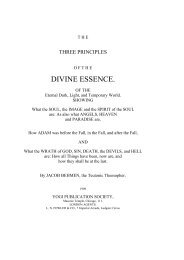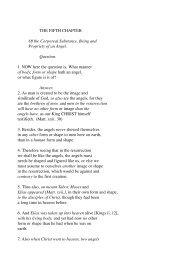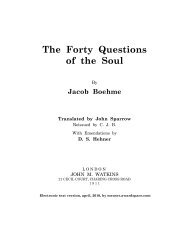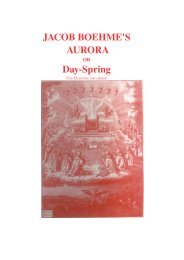Gerald Massey's Lectures - Society in evolution - Awardspace
Gerald Massey's Lectures - Society in evolution - Awardspace
Gerald Massey's Lectures - Society in evolution - Awardspace
You also want an ePaper? Increase the reach of your titles
YUMPU automatically turns print PDFs into web optimized ePapers that Google loves.
In a later form of the Osirian legend the Tw<strong>in</strong>s are the double Horus, <strong>in</strong>stead of the Sut-<br />
Horus of the Typhonian myth. In this we see the little dark child eyeless, soulless,<br />
maimed <strong>in</strong> his lower members, go<strong>in</strong>g <strong>in</strong>to Tattu to meet his soul, his other self, his<br />
glorified body, the double, like that of Buddha, which was called his diamond body. This<br />
other self is designated the soul of the sun, and it is this which revivifies, regenerates, and<br />
transforms the child of the mother-moon <strong>in</strong>to the virile Horus, the new moon horned and<br />
pubescent. There is a tradition preserved by Plutarch that the child Horus, the cripple<br />
deity, begotten <strong>in</strong> the dark, was the result of Osiris hav<strong>in</strong>g accompanied with Isis after her<br />
decease, or with Nephthys her sister, below the horizon. Even this representation is<br />
perfectly correct accord<strong>in</strong>g to the natural phenomena. Isis personates the moon, which<br />
dies to be aga<strong>in</strong> renewed. The renewal occurs <strong>in</strong> the under-world, and is out of sight or all<br />
<strong>in</strong> the dark. Osiris, as the sun below the horizon is the renovator of the old, dead orb of<br />
the moon, which he causes to re-live with his light; hence the fable of his accompany<strong>in</strong>g<br />
with Isis after her demise is <strong>in</strong> accordance with the mythical mode of represent<strong>in</strong>g the<br />
phenomena of external nature <strong>in</strong> human imagery.<br />
In one of its phases the moon was portrayed <strong>in</strong> the character of a thief, which was<br />
personated by the jackal, ape, or wolf, who represented Goddess 15. Ishtar is described as<br />
ascend<strong>in</strong>g and descend<strong>in</strong>g the steps of the moon, so many days up and so many days<br />
down--of these days there would be fifteen altogether, <strong>in</strong> accordance with her name of<br />
Goddess 15. And here the Christian Mary can be identified <strong>in</strong> this lunar character by<br />
means of the Apocryphal Gospels, that conta<strong>in</strong> legends of the <strong>in</strong>fancy which are of<br />
primary importance, hence they have been denounced as spurious, excommunicated as<br />
heretical, and kept out of sight by Papal commands. In pseudo Matthew (ch. iv.), we learn<br />
that when the Virg<strong>in</strong> was an <strong>in</strong>fant, just weaned, she ran up the fifteen steps of the temple<br />
at full speed, without once look<strong>in</strong>g back. At this age she was regarded as an adult of<br />
about thirty years! The story of the fifteen steps is repeated <strong>in</strong> the Gospel of Mary's<br />
nativity (ch. vi.), where the fifteen steps are associated with the fifteen Psalms of degrees.<br />
Further, it was on the 15th day of the moon that the dark one of the tw<strong>in</strong>s was re-born, as<br />
the lessen<strong>in</strong>g, wan<strong>in</strong>g one of the two; and <strong>in</strong> the history of Joseph the carpenter, Jesus<br />
says that Mary gave him birth <strong>in</strong> the fifteenth year of her age, by a mystery that no<br />
creature can understand except the Tr<strong>in</strong>ity. The Tr<strong>in</strong>ity be<strong>in</strong>g lunar, the subject matter is<br />
identical accord<strong>in</strong>g to the Gnosis of numbers, and Mary is also a form of the Goddess<br />
15,--Meri, or Hathor-Meri, <strong>in</strong> the Egyptian Mythos.<br />
It is only <strong>in</strong> lunar phenomena that we can see how the child could be born from the side<br />
of its mother, as Sut-Horus was, as well as the Buddha, or the Christ. Also, the div<strong>in</strong>e<br />
child, as Buddha, was said to be visible whilst <strong>in</strong> the mother's womb. The womb of the<br />
mother be<strong>in</strong>g the lunar orb <strong>in</strong> which the child <strong>in</strong> embryo can be seen <strong>in</strong> course of growth,<br />
it was represented as be<strong>in</strong>g transparent with the child on view. The child Jesus is so<br />
pourtrayed <strong>in</strong> the Christian pictures of the enciente Virg<strong>in</strong> Mary, as may be seen <strong>in</strong><br />
Didron's Iconography!<br />
The birth of the dark one of the mother-moon's two children, depends upon that part of<br />
the lunar orb which is turned away from the sun, be<strong>in</strong>g dimly seen through the light<br />
reflected from our earth. As the light began to lessen, and the orb became opaque, there<br />
was an obvious birth of the dark part of the moon! That was the birth of the little, dark<br />
one, of the lunar tw<strong>in</strong>s. So f<strong>in</strong>e a po<strong>in</strong>t of departure from the light half to the dark, and<br />
from the dark half to the light, may be likened to a s<strong>in</strong>gle hair--as it was <strong>in</strong> the H<strong>in</strong>du<br />
mythos, which represents Krishna as be<strong>in</strong>g born from a s<strong>in</strong>gle black hair and Balarama<br />
from a s<strong>in</strong>gle white hair of Vishnu. This is, probably, the mythical mean<strong>in</strong>g of a say<strong>in</strong>g<br />
attributed to the Christ <strong>in</strong> the gospel of the Hebrews,--"And straightway," said Jesus, "the<br />
holy spirit (my mother) took me and bore me by one of the hairs of my head, to the great<br />
mounta<strong>in</strong> called Thabor." The exact colour of the dark orb is slate-black, and this has<br />
been preserved <strong>in</strong> India as the complexion of the dark child, Hari or Krishna. These types



